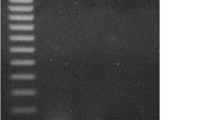Abstract
Purpose
Alteration and overexpression of HER2 proto-oncogene have been implicated in the carcinogenesis and prognosis of ovarian cancer. We evaluated this hypothesis among women with ovarian carcinoma patients from Tiruchirapalli, Tamil Nadu, India.
Methods
Genomic DNA was extracted from 72 case patients and 288 control subjects and was examined for I655V polymorphism by PCR–RFLP based assay. Immunohistochemistry analysis was carried out in order to study the overexpression of HER2 protein. The observed number of each genotype was compared with that expected for a population in the Hardy–Weinberg equilibrium. In analysing the relation between genotype and overexpression of HER2 protein, Cochran-Mantel–Haenszel statistics was used.
Results
We found that 20.8 % of the case patients and 16.3 % of the control subjects were heterozygous for the Val allele and 10 case patients (13.8 %) and 3 control subjects (1.1 %) were homozygous for this allele (P < 0.001). Compared with women with Ile/Ile genotype, women with Val/Val genotype had an elevated risk of ovarian cancer. The genotype distributions were consistent with the Hardy–Weinberg equilibrium. The risk increased with the number of Val allele and women homozygous for the Val allele had 15-fold (OR = 15.3; 95 %CI = 4.09–57.31) increased risk of cancer. The patients homozygous for the Valine allele showed strong HER2 protein expression.
Conclusion
The results showed that the valine allele may be an indicator of genetic susceptibility to ovarian carcinoma in the study population.

Similar content being viewed by others
References
Gadducci A, Cosio S, Gargini A et al (2004) Sex-steroid hormones, gonadotropin and ovarian carcinogenesis: a review of epidemiological and experimental data. Gynecol Endocrinol 19:216–228
Tingulstad S, Skjeldestad FE, Halvorsen TB et al (2003) Survival and prognostic factors in patients with ovarian cancer. Obstet Gynecol 101:885–891
Parazzini F, Franceschi S, La Vecchia C et al (1990) Review: the epidemiology of ovarian cancer. Gynecol Oncol 43:9–23
National Cancer Registry Program (2010) Three year report of population based cancer registries (2006–2008), Bangalore, India
Roses AD (2004) Pharmacogenetics and drug development: the path to safer and more effective drugs. Nat Rev Genet 5:645–656
Medeiros R, Pereira D, Afonso N et al (2003) Platinum/paclitaxel-based chemotherapy in advanced ovarian carcinoma: glutathione S-transferase genetic polymorphisms as predictive biomarkers of disease outcome. Int J Clin Oncol 8:156–161
Roskoski R (2004) The ErbB/HER receptor protein-tyrosine kinases and cancer. Biochem Biophys Res Commun 319:1–11
Akiyama T, Sudo C, Ogawara H et al (1986) The product of the human c-erbB-2 gene: a 185-kilodalton glycoprotein with tyrosine kinase activity. Science 232:1644–1646
Graus-Porta D, Beerli RR, Daly JM et al (1997) ErbB-2, the preferred heterodimerization partner of all ErbB receptors, is a mediator of lateral signalling. Eur Med Biol Org J 16:1647–1655
Sliwkowsk MX, Schaefer G, Akita RW et al (1994) Coexpression of erbB-2 and erbB-3 proteins reconstitutes a high affinity receptor for heregulin. J Biol Chem 269:14661–14665
Di Fiore PP, Pierce JH, Kraus MH et al (1987) erbB-2 is a potent oncogene when overexpressed in NIH/3T3 cells. Science 237:178–182
Stern DF, Kamps MP, Cao H (1988) Oncogene activation of p185neu stimulates tyrosine phosphorylation in vivo. Mol Cell Biol 8:3969–3973
Papewalis J, Nikitin AY, Rajewsky MF (1991) G to A polymorphism at amino acid codon 655 of the human erbB-2/HER2 gene. Nucleic Acids Res 19:5452
Hishida A, Hamajima N, Iwata H et al (2002) Re: population-based, case–control study of HER2 genetic polymorphism and breast cancer risk. J Natl Cancer Inst 94:1807–1808
Xie D, Shu XO, Deng Z et al (2000) Population-based, case–control study of HER2 genetic polymorphism and breast cancer risk. J Natl Cancer Inst 92:412–417
Mullenbach R, Lagoda PJ, Welter C (1989) An efficient salt–chloroform extraction of DNA from blood and tissues. Trends Genet 5:391
Pinto D, Pereira D, Portela C et al (2005) The influence of HER2 genotypes as molecular markers in ovarian cancer outcome. Biochem Biophys Res Commun 335:1173–1178
Spitz MR, Wu X, Mills G (2005) Integrative epidemiology: from risk assessment to outcome prediction. J Clin Oncol 23:267–275
Bargmann CI, Hung MC, Weinberg RA (1986) Multiple independent activations of the neu oncogene by a point mutation altering the transmembrane domain of p185. Cell 45:649–657
Guy CT, Webster MA, Schaller M et al (1992) Expression of the neu proto-oncogene in the mammary epithelium of transgenic mice induces metastatic disease. PNAS 89:10578–10582
Keshava C, McCanlies EC, Keshava N et al (2001) Distribution of HER2(V655) genotypes in breast cancer cases and controls in the United States. Cancer Lett 173:37–41
Millikan R, Eaton A, Worley K et al (2003) HER2 codon 655 polymorphism and risk of breast cancer in African American and whites. Breast Cancer Res Treat 79:355–364
Ameyaw MM, Thornton N, McLeod HL (2000) Re: population based, case–control study of HER2 genetic polymorphism and breast cancer risk. J Natl Cancer Inst 92:1947
Akisik E, Dalay N (2004) Estrogen receptor codon 594 and HER2 codon 655 polymorphisms and breast cancer risk. Exp Mol Pathol 76:260–263
Fasching PA, Gayther S, Pearce L (2009) Role of genetic polymorphisms and ovarian cancer susceptibility. Mol oncol 3:171–181
Fleishman SJ, Schlessinger J, Ben-Tal N (2002) A putative molecular activation switch in the transmembrane domain of erbB2. PNAS 99:15937–15940
Acknowledgments
The authors greatly acknowledge Indian Council of Medical Research, New Delhi for the financial support (3/2/2/63/2011/NCD-III; 5/13/88/06/NCD-III). The authors acknowledge the Vice Chancellor of Bharathidasan University for providing the infrastructure facility to carry out the research work. The authors thank Dr. V. J. Senthil, Director, GVN Institute of Cancer, India.
Conflict of interest
None.
Author information
Authors and Affiliations
Corresponding author
Rights and permissions
About this article
Cite this article
Shanmughapriya, S., Senthilkumar, G., Arun, S. et al. Polymorphism and overexpression of HER2/neu among ovarian carcinoma women from Tiruchirapalli, Tamil Nadu, India. Arch Gynecol Obstet 288, 1385–1390 (2013). https://doi.org/10.1007/s00404-013-2892-y
Received:
Accepted:
Published:
Issue Date:
DOI: https://doi.org/10.1007/s00404-013-2892-y




